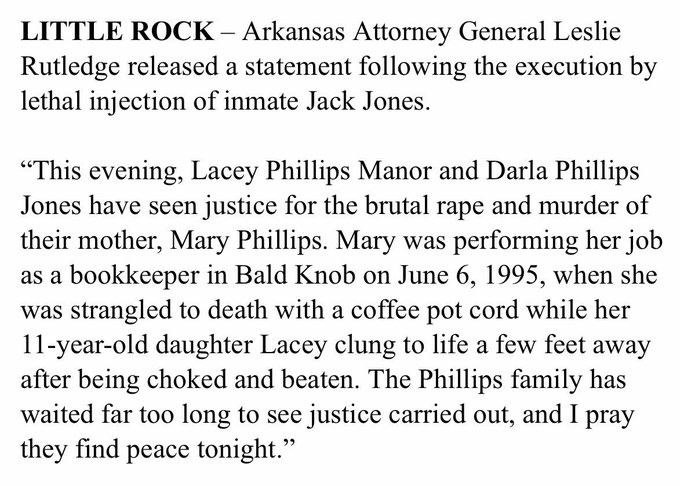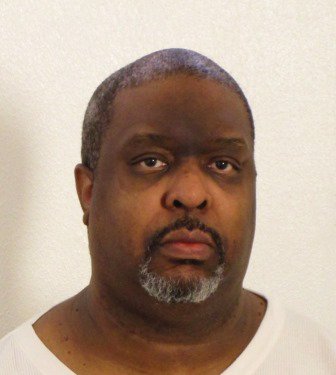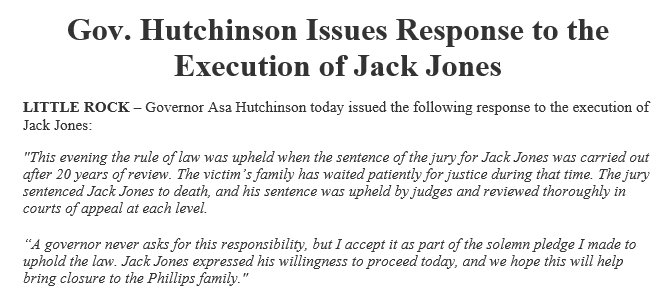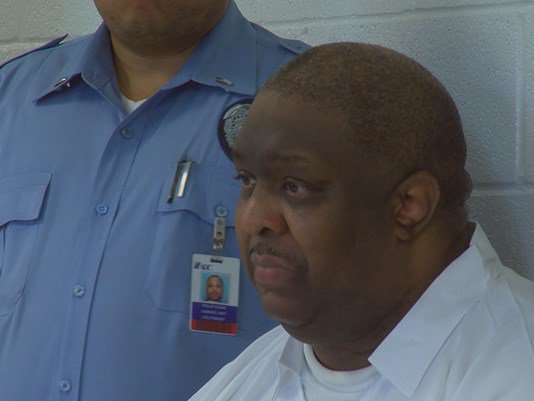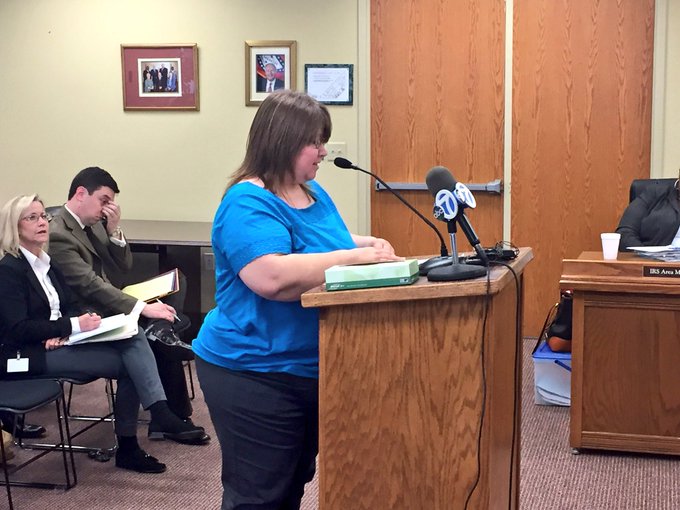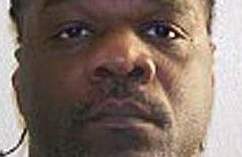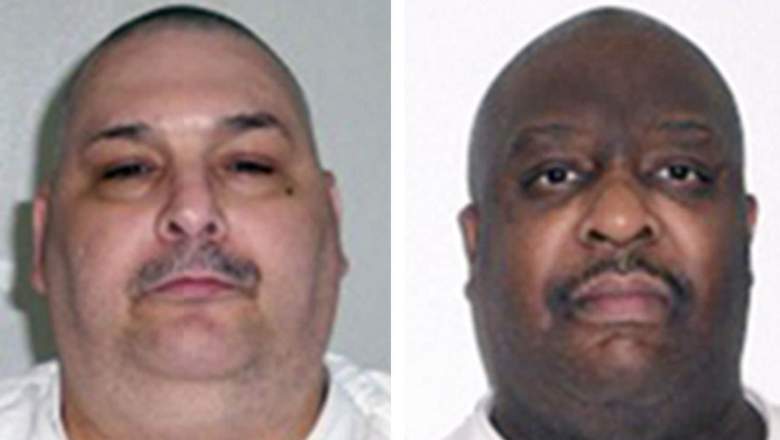
Jack Harold Jones and Marcel Williams. (Corrections photos)
Jack Harold Jones and Marcel Williams were executed by the State of Arkansas on April 24, as the state continues implementing a controversial speedy execution plan.
It was the first dual execution in the United States in 17 years.
Jones was put to death first at 7:20 p.m. CDT after dining on a last meal of Butterfingers and chicken:
Williams was originally scheduled to die at 8:15 p.m. Williams’ lawyers argued for an emergency stay on the basis of Jones’ execution being inhumane, and a stay was briefly granted by a judge. However, a short time later, the stay was lifted. At 10:20 p.m., the media were still reporting that no word had come from the execution chamber:
Then, at 10:33 p.m. came word that Williams too had been executed (the lethal injection was administered at 10:16 p.m.) He had no final words.
Williams’ lawyers say Jones’ death was inhumane; according to the Death Penalty Information Center, “Mr. Jones was moving his lips and gulping for air” after consciousness checks were performed. Media witnesses disputed that account, though:
Both men were convicted of the rape and murder of young mothers. Their cases have not revolved around claims of innocence like those in some of the other Arkansas death penalty cases.
In his last statement, Jones said of the 11-year-old girl whom he beat while killing her mother that he loves her “like my child.”
The State of Arkansas is trying to execute eight inmates in all in 11 days in what critics are deriding as an unprecedented “conveyor belt” implementation of the death penalty.
The state is moving so fast because a drug it uses to administer lethal injections is set to expire. The state “had earlier planned to execute eight inmates …before Arkansas’ supply of the drug runs out at the end of the month,” starting on April 17, reported CNN.
Despite court intervention, the state executed the first of the 8 – Ledell Lee – on the evening of April 20. Jones and Williams were next in line, although others of the group have received stays.
Here’s what you need to know:
1. Jones Was Convicted of Murdering and Raping a Mother in Front of Her Young Daughter
The crime that landed Jones on death row still plays out in the minds of seasoned lawmen, who have described in the media discovering a child alive in the midst of the horrific crime scene – after they’d started photographing what they thought was her dead body.
The governor released a statement after Jones’ execution, saying that the “rule of law” had been upheld as a result.
The state disputed allegations from Williams’ attorneys that Jones’ execution was inhumane.
Jones’ last meal included candy bars, chicken, and fruit punch. Reporter Mitchell McCoy has posted a moment-by-moment description of Jones’ execution on Twitter.
Jones’ sister pleaded with authorities to let her watch her brother’s execution, but they refused, according to KATV, which added that Jones told a clemency board he wanted to be executed.
According to the AP, Jones “was convicted of killing bookkeeper Mary Phillips in 1995 and trying to kill her daughter, Lacy, during a robbery at an accounting office. Phillips was found naked from the waist down with a cord from a nearby coffee pot tied around her neck. Lacy, left for dead, woke up as police photographed her.”
Lacy was only 11.
The attack was horrific. A court decision in the case contains graphic details. Jones might never have been caught, except the child survived the attack. In fact, law enforcement officers who showed up at the scene were photographing what they thought was her dead body when they realized she was still alive.
The court decision says, in part: “When he (Jones) returned, Lacy, now crying, asked the man not to hurt her mother, to which he replied, ‘I’m not. I’m going to hurt you.’ He began to choke Lacy until she passed out. After Lacy lost consciousness, Jones struck her at least eight times in the head with the barrel of a BB gun, causing severe lacerations and multiple skull fractures.”
The child clung to life. “When Lacy woke up, she saw blood and began to vomit. She went back to sleep and awakened later when police, seeing her bloodied body and thinking she was dead, were taking photographs of her,” court records say.
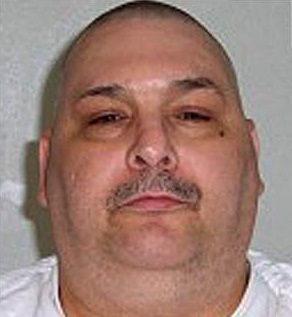
Jack Harold Jones correction photo.
Police found a gruesome scene: “Mary’s body nude from the waist down. A cord from a nearby Mr. Coffee pot was wrapped around her neck and wire was tied around her hands, which were positioned behind her back. Bruises on her arms and back indicated that she had struggled with her attacker prior to her death. According to autopsy results, Mary died from strangulation and blunt-force head injuries. Rectal swabs indicated that she had been anally raped before she was killed.”
Jones confessed that “he had committed the crimes because he wanted to get revenge against the police. He reasoned that his wife had been raped, and that the police had done nothing about it.”
According to the Fair Punishment Project, “Jack Jones suffers from bipolar disorder and depression. His symptoms of serious mental illness date back to his childhood. He endured visual hallucinations where he saw ‘bugs, ants and spiders in particular, that he believed were going to get him.'”
The report says that family members described how on other occasions, “he would sometimes rock and bang his head against the cupboards. A doctor at the time diagnosed him with ADHD and prescribed Ritalin. In 1980, when Jack was 16, a doctor recommended he receive psychotherapy and family counseling, but the family did not follow through.”
The report describes other psychiatric troubles: “In 1989, Jack attempted suicide. He tried again in 1991, when he jumped off a bridge. He was finally admitted for psychiatric attention.Just months prior to the capital murder, Jack voluntarily committed himself to the Pinnacle Pointe Hospital in Little Rock, reporting severe depression and repeated suicidal ideation. He was diagnosed with bipolar disorder and prescribed Lithium. He received the bipolar diagnosis again just weeks before the capital murder, in May of 1995. Jack also experienced physical abuse by his father, and sexual abuse at the hands of three strangers who abducted and raped him.”
The report adds, “His trial lawyers spent a grand total of $6,641.95 preparing his defense, including plane tickets for the witnesses, lodging, and food. They also used an expert at the 1996 trial who had surrendered his medical license in 1993 to enter substance abuse treatment. His license was reinstated in 1994, but he remained under supervision of the Medical Board, which issued an emergency stay in 1997 after a finding that he had “bec[o]me mentally incompetent to practice medicine to such an extent as to endanger the public.” The expert told the jury that he knew that Jack was not bipolar because he was bipolar himself.”
2. Marcell Williams Was Convicted of Suffocating a Young Mother He Abducted When She Stopped for Gas
Marcel Williams, the second inmate scheduled to die on April 24, confessed to suffocating “a young mother of two after raping her” and abducting her when she stopped for gas, USA Today reports. Her name was Stacy Errickson.
According to THV11, “Her body was found in a shallow grave weeks later.”
Williams requested a last meal that included Mountain Dews and nachos. Errickson’s family declined to speak with the news media on the night of his execution, according to Mitchell McCoy, a reporter with KARK4News. McCoy wrote, “Marcel Williams was in the chamber, on the gurney when the stay was issued.” That’s the stay that was then lifted. McCoy also wrote of the execution: “Media witnesses report from 10:17-10:20, Williams’ head was going back w/ heavy breathing.”
Death penalty opponents said prayers as the execution was unfolding.
The governor released a statement after the execution:
A court decision in the case describes the gruesome details: “On November 20, 1994, Stacy Errickson, the victim, on her way to work, stopped at the Jacksonville Shellstop for gas. The time was approximately 6:45 a.m. Williams approached Errickson’s vehicle, drew a firearm, and forced her to move from the driver’s seat to the passenger’s side. Williams then drove Errickson’s car away from the convenience store. Williams then took Errickson to several automated teller machines and coerced her to attempt withdrawals. A total of eighteen transactions yielded the sum of $350. The last transaction occurred at 7:37 a.m. These transactions were recorded by security cameras at several banking facilities. Stacy Errickson did not make it to work that day, nor did she pick up her child from the babysitter at the end of the day.”
The decision continues: “Police arrested Williams on an outstanding warrant on November 29, 1994, and questioned him based on physical evidence linking him to two other assaults on women. During the course of an intensive interrogation lasting some thirteen hours, Williams admitted having abducted Errickson from the convenience store and robbing her through ATM withdrawals. However, he denied any sexual assault and assured the officers that to the best of his knowledge Errickson was alive. Appellant attempted to implicate others as accomplices asserting that they were the ones responsible for physically harming her.”
However, based upon information Williams supplied, “the police recovered a sheet matching Williams description as one he used in connection with the abduction and also recovered a gold ring which Williams identified. On December 5, 1994, police discovered Stacy Errickson’s body buried in a shallow grave. Other evidence adduced at trial indicated that witnesses Tammy Victoria and Tammy Keenahan identified Williams as a man they had seen on the morning of November 20, 1994, at the Shellstop. They also testified that after they left the station he followed them in a car and attempted to stop them until they sought refuge at the air force base. Williams subsequently returned to the Shellstop and abducted Stacy Errickson.”
Errickson’s last moments were horrific. The court decision described: “The State’s evidence reflected Williams forcibly abducted Stacy Errikson, robbed her, raped her, and killed her. It further showed Errikson had a significant period of time to contemplate her fate. The physical evidence established a violent physical assault by appellant against the victim. Injuries to her head indicated deep bruising to her neck and to her face. he victim was bound with her hands behind her back. The medical testimony further indicated her death was by asphyxiation from strangulation.”
Williams had four prior felony convictions.
The Fair Punishment project also has a report on Williams’ life. It says that, by the time Williams was nine or ten, “he was the victim of sexual abuse. His mother presented him to her adult friend as a sexual partner so that the family could live in her house. By the time he was twelve, Marcel’s ‘mother was routinely pimping him. . . . in exchange for food stamps, for food, for a place to stay. . . . to women in their twenties, thirties, and forties. He [wa]s twelve, thirteen, fourteen years old.’ While serving time in an adult prison as an adolescent, Marcel also was violently gang-raped by three people.”
His mother “was described by an expert as ‘catastrophically unfit’ to be a parent” and “also physically abused him in ‘unrelenting’ and ‘savage’ ways,'” the report says. It adds: “According to Marcel’s sister, his mother beat him ‘almost every day’ and ‘usually used a belt or switch.’ ‘When it was real bad, she used an extension cord.’ One time, according to his cousin, his mother ‘got a pot and put water in it and put extension cords in it to boil them, then she took them out and went into the room and started to beat (Williams).'”
His cousins “could hear him screaming, and after a while saw him run out of the room and through the house, naked, and out into the backyard [and] [h]e had gashes and he was bleeding,” the report said, adding that, another time, “she used an electric coil to burn him. He also was stabbed after defeating an older kid in a craps game. He grew up in crushing poverty. His house was full of roaches and rodents and the utilities were often turned off. At times, Marcel and his sister literally did not have shoes to wear.”
3. The Families of Both Women Say the Executions Will Bring Some Sense of Closure
The child who survived Jones’ attack has spoken out in favor of his execution.
Lacy Phillips has said, “I don’t want to live another day knowing that he’s alive. Twenty-one years and he’s still here and we still have go through this, we still have to see it, we still have to talk about it,” according to Arkansas Times.
“My wife suffered big time,” said the husband of Mary Phillips.
Bill Lindsey found 11-year-old Lacy in the closet and recalled it for THV11: “Lacy’s dark brown hair covers the right side of her face. It’s matted and made darker by blood. In the middle is Lacy’s bright, round eye staring back at the camera.” Had she not survived, they might not have caught Jones.
Jones told a clemency board that “his actions were the result of years of mental illness, abuse, drug use and bad choices,” according to the news site.
At a clemency hearing, another woman raped and tied up by Williams said his life should be spared.
“This man has turned his life around, and he’s found God,” said Dina Windle, who asked the parole board to spare Williams’ life, according to THV11.
According to the television station, Williams “asked for forgiveness from his victims during the hearing, saying, ‘To those I’ve hurt, ‘I’m sorry’ is not enough.’” The clemency board turned down the request to save his life. By age 12, Williams’ mother was “routinely pimping him” in exchange for good stamps and money, acording to THV11.
Death Penalty News says that Williams was severely abused in childhood: “According to the Eighth Circuit’s summary of the evidentiary hearing held by US District Court Judge Leon Holmes in December 2006, ‘living in poverty and neglect, Williams began stealing and shoplifting to support his siblings’, and spent time in juvenile facilities when he was between 12 and 14. ‘He resumed stealing shortly after his release and was convicted of aggravated robbery as an adult in 1986, when he was sixteen. He was sentenced to eight years in prison, where he allegedly was raped by three fellow inmates’.”
The site continues: “A key witness at the District Court evidentiary hearing was Dr David Lisak, an expert in psychological trauma, child abuse, and the relationship between abuse and violence. The summary of his testimony provided by Judge Holmes includes the following: ‘The physical abuse that Mr Williams endured was unrelenting. He was beaten by his stepfather, and by his mother. His mother was probably the major perpetrator simply because she was around for a longer period of time. The abuse was really hideous. They both beat him with their fists. They used belt buckles. They used extension cords. On two occasions, his mother deliberately burned him, once with boiling water and the other time with an electric coil… There were many occasions in which Mr Williams was left with welts, cuts, bleeding cuts… ”
However, Errickson’s mother, and the woman who was babysitting her children, have a different view. “Stacy wasn’t raised by a daddy. She didn’t have one, and her twin brother Tracy didn’t have one,” Carolyn Moore, Errickson’s mother, said, according to THV11, which added that she wants Williams executed. “Neither one of those were in jail, so that’s no excuse for these convicts.”
“I still think of her every day and always will,” babysitter Trista Wussick said, according to the television station. “Marcel Williams is my boogie man. He doesn’t deserve any mercy.”
4. A Judge Declined to Block the Executions of Jones & Williams Even Though Other Inmates Won Reprieves
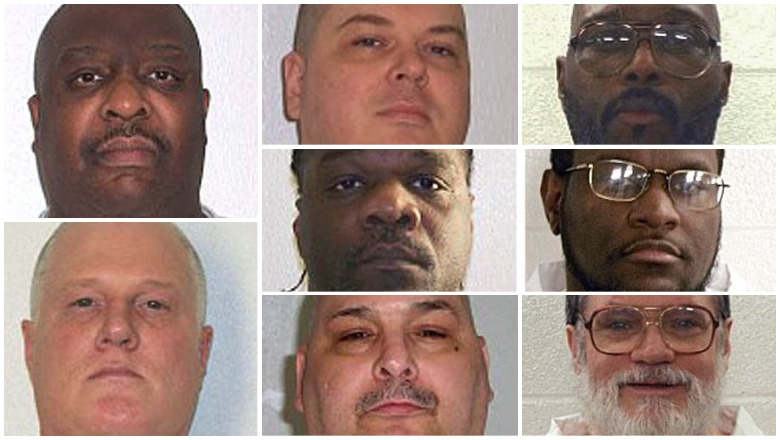
The eight inmates that Arkansas is trying to put to death. (Correctional photos)
Multiple courts have intervened in a variety of ways to halt the speedy execution plan, and as of April 19, the executions were temporarily halted after two court decisions came down amidst a flurry of them. However, CNN reports that the Arkansas Supreme Court reversed a judge’s restraining order that had halted the executions.
On April 21, a judge in Arkansas declined to stop the executions of Jones and Williams.
According to NBC News, the men “asked the courts to stop the Arkansas Department of Correction from using midazolam because they believe it would cause them unnecessary harm due to their obesity and other health reasons.” A federal judge disagreed, ruling, that the men’s argument “falls short of demonstrating a significant possibility … that the Arkansas protocol is ‘sure or very likely’ to cause severe pain and needless suffering,” reports NBC, which says “Midazolam is the first drug in a three-drug lethal injection cocktail that is meant to render the inmate unconscious.”
The rapid pace of compressed executions the state wanted to carry out would have made it unique since at least 1976. According to The Chicago Tribune, “The state set the compressed schedule because its supply of one of the lethal injection drugs expires at the end of April” 2017.
The eight executions – almost one per day – “would have been the most by a state in such a compressed period since the U.S. Supreme Court reinstated the death penalty in 1976,” reported ABC News.
It’s all a remarkable move by a state that hasn’t put anyone to death for a decade, according to The Huffington Post.
According to The New York Daily News, “Midazolam is a common sedative used typically by medical doctors. The drug is designed to sedate or relax the patient before undergoing minor surgical procedures,” and it has been used in executions since 2013 but there have been reports of inmates waking up.
The drug company has gone to court to try to halt the execution plan, and it won a critical ruling (although it can be appealed, and the state AG says it will be). The practical effect of the April 19 ruling is that it stops – at least for now – the state’s plan to put all eight inmates to death. But that was the ruling overturned.
There was an odd twist leading up to the recent ruling. The week before, a different judge, Wendell Griffen, issued a similar ruling – saying the state couldn’t use the drug vecuronium bromide – “but the Arkansas Supreme Court vacated Griffen’s ruling days after he participated in an anti-death penalty rally,” ABC News reported.
In a statement, Griffen explained why he lay motionless on a cot in front of the Arkansas governor’s mansion:
According to The Huffington Post, McKesson Corp, which supplied the drug to Arkansas argued in court that the “state misleadingly obtained its product.”
The company wrote in its court filing that the drug has a “number of beneficial uses in traditional surgical settings” but is “also used by some state correctional facilities as an essential component of those states’ and facilities’ capital punishment regimen.”
McKesson claims that the manufacturer of the drug has “included clauses in its sale agreements that prohibit distributors from selling specific drugs that are capable of being used in capital punishments to federal and state correctional facilities that engage in capital punishment.”
The company claims that it was “led to believe that the order was placed at the request of or for the benefit of the licensed physical and would be used for a legitimate medical purpose… In fact (Arkansas) intended to use this product in connection with executions, a fact that was never disclosed to McKesson.”
5. One of the Eight Inmates, Stacey Johnson, Was Granted a Reprieve to Try to Prove His Innocence but Ledell Lee Was Executed
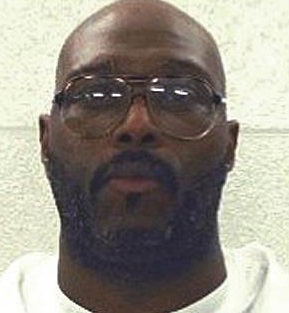
Stacey Johnson correctional photo.
One of the flurry of court hearings involves an inmate who insists he’s innocent and wanted a chance to see if DNA could prove it.
According to CNN, the state Supreme Court “granted inmate Stacey Johnson a stay” on April 19, the day before he was scheduled to be executed, “ruling 4-3 that he has a right to an evidentiary hearing after he requested DNA testing to prove his innocence.”
Johnson is on death row in the murder of a young mother named Carol Heath, “who was beaten and had her throat slit in her flat in 1993” while her children were in the home, reports BBC.
According to the Innocence Project, Heath “was attacked in her home sometime on either April 1 or 2, 1993. Heath was found on her living room floor wearing only a t-shirt. The evidence suggested that she had been raped, strangled and then stabbed in the throat. Her purse was later found at a highway rest stop. Near the purse were two shirts subsequently determined by DNA testing to be stained in the victim’s blood.”
The victim’s six-year-old daughter identified Johnson as the murderer, according to the Innocence Project. The project noted, “A New Mexico police officer also claimed that Johnson admitted to the murder in passing, despite the officer’s failure to mention the admission in any report or in the detailed written statement he obtained from Johnson.”
The first conviction was overturned, and Johnson was retried and convicted. He had admitted previously being in the victim’s apartment, and “Johnson’s DNA was identified on hairs recovered from the victim’s apartment…and a cigarette butt that was allegedly recovered from the pocket of a sweat shirt found at a highway rest stop along with the victim’s purse,” says the Innocence Project. Among other arguments, the Innocence Project contends that DNA testing has so advanced that other items can now be tested that might yield DNA. The victim had bite marks on her breasts, and a man with whom there was a history of domestic violence had abused his ex-wife in that manner.
“Caucasian hairs were collected from the scene and from one of the shirts found stained in the victim’s blood,” and the child’s therapist thought she was being pressured to identify Johnson, reports the Innocence Project.
Johnson wanted the chance to seek new DNA testing in lower courts and was granted it.
One-by-one, the inmates have been granted stays of executions by various courts, but one inmate has already been executed among the eight: Ledell Lee. The case was also notable because it marked new Supreme Court Justice Neil Gorsuch’s first publicly recorded vote. He was the deciding vote to allow the execution to proceed.
Lee was convicted in the murder of Debra Reese. According to THV-11, Reese was raped and murdered in her home in 1993 at age 26 and was “struck approximately 36 times with a tire thumper, a tool used by truck drivers to check their tire pressure.” Her husband had given it to her for protection because he was a trucker who was often gone, the television station reported.
According to THV, Lee was arrested after “witnesses claimed they saw him walking down the street that Reese’s house was on,” but he says he’s innocent. The television station reports that Lee was suspected of other crimes by authorities, including the strangulation and rape of another woman, but that trial ended in a hung jury. He was also convicted of two other rapes, reported THV.
The ACLU reports that Lee has raised other issues in court, arguing that “he has fetal alcohol syndrome disorder, significant brain damage, and intellectual disability. These facts were concealed by the line of counsel plagued with conflicts of interests, substance abuse, serious mental illness, and gross incompetence.”
There were other odd and disturbing twists in the case. “Lee was tried by a judge who concealed his own conflict of interest: an affair with the assistant prosecutor, to whom the judge was later married. Mr. Lee’s first state post-conviction counsel introduced the evidence of the affair by calling the judge’s ex-wife, who testified about the affair after opposing the subpoena. That lawyer, however, was so intoxicated at the hearing that the state moved for him to be drug tested after he slurred, stumbled, and made incoherent arguments,” the ACLU reports.
The Innocence Project reports that Lee wants new DNA testing in the case: “Numerous unknown fingerprints were found at the crime scene, yet none were from Lee. At trial, the prosecution claimed that two small spots of ‘human blood’ on shoes recovered by the police from Lee were likely the victim’s blood. Yet despite the extremely bloody nature of the crime, no other blood was found anywhere on Lee’s shoes, or any of his clothing. Newly available DNA testing could prove whether the spots were in fact victim’s blood.”
The Innocence Project says there are also hairs it wants tested that “the state’s experts claimed that the hairs were ‘consistent’ with Lee’s based on microscopic examination – a forensic method that has since been discredited.”
According to the Tribune, two of the other inmates won reprieves on arguments revolving around mental illness.
